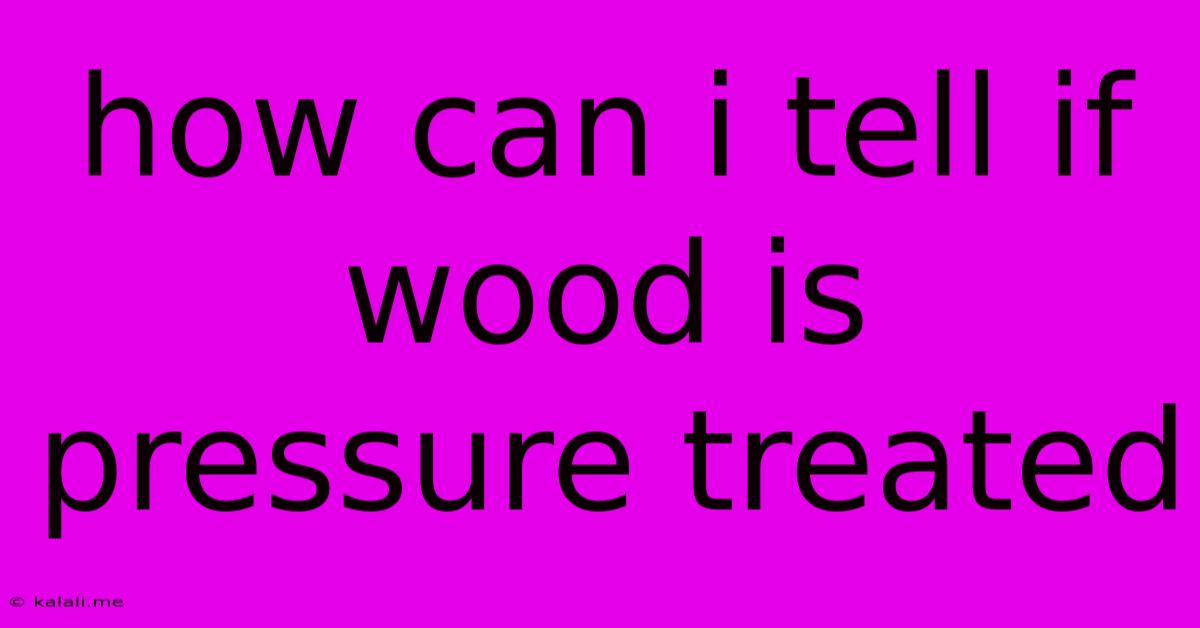How Can I Tell If Wood Is Pressure Treated
Kalali
Jun 02, 2025 · 3 min read

Table of Contents
How Can I Tell if Wood is Pressure Treated? A Comprehensive Guide
Knowing whether wood is pressure treated is crucial for various projects, from building a deck to crafting outdoor furniture. Pressure-treated lumber is designed to resist rot, decay, and insect infestation, making it ideal for exterior applications. However, identifying pressure-treated wood isn't always straightforward. This guide will provide you with multiple methods to determine if your wood has undergone this essential treatment.
Why is Identifying Pressure-Treated Wood Important?
Using the wrong type of wood can lead to costly repairs and replacements down the line. Untreated wood exposed to the elements will quickly deteriorate, requiring expensive repairs or complete reconstruction. Understanding how to identify pressure-treated lumber is vital for ensuring the longevity and structural integrity of your projects. This knowledge is valuable for both DIY enthusiasts and seasoned professionals alike. Correct identification also impacts safety; some older pressure-treating chemicals posed health risks.
Visual Inspection: The First Step
While not foolproof, a visual inspection can offer initial clues. Look for the following:
- Color: Pressure-treated wood often has a distinct greenish, brownish-green, or yellowish-green hue. However, the color can vary depending on the type of preservative used and the wood species. The color might be more pronounced on the end grain.
- Branding: Many manufacturers stamp or brand their pressure-treated lumber. Look for markings indicating the type of treatment (e.g., CCA, CA-B, ACQ). These marks usually appear on the ends of the lumber. However, branding might be absent on reclaimed lumber.
- Texture: While not always reliable, pressure-treated wood may feel slightly different to the touch than untreated lumber. It might seem slightly smoother or rougher depending on the preservative and wood type.
Beyond Visual Inspection: More Reliable Methods
While visual inspection can be helpful, it's not a definitive method. For a more accurate assessment, consider these additional techniques:
The Smell Test: A Simple Check
This method relies on detecting the characteristic odor associated with certain preservatives. Older CCA-treated wood often has a distinct, slightly acrid smell. However, newer preservatives have less pungent odors, making this method less reliable for modern lumber.
Testing for Chemical Residues: A More Scientific Approach
This method involves testing for the presence of chemical preservatives in the wood. Although this may not be easily feasible at home, professional labs can perform such tests.
Checking with the Supplier: The Easiest Option
If you purchased the wood recently, the easiest way to know for sure is to contact the supplier. They should be able to provide details about the lumber's treatment. Keep your receipts for easy reference. This is especially important if you’re working with a large quantity of lumber for a major project.
Understanding Different Pressure-Treating Chemicals
It's important to understand that pressure-treating chemicals have evolved over time. Older treatments like Chromated Copper Arsenate (CCA) are no longer widely used due to environmental concerns. Newer alternatives, such as Alkaline Copper Quaternary (ACQ) and Copper Azole (CA-B), are considered more environmentally friendly. The method of identification may differ slightly depending on the preservative used.
Conclusion: A Multifaceted Approach
Identifying pressure-treated wood requires a multifaceted approach combining visual inspection with additional methods. While a visual inspection provides a preliminary assessment, confirming the treatment through the supplier or professional testing ensures accuracy and safety. Remember to always prioritize safety and handle lumber responsibly, regardless of its treatment. Careful attention to these details ensures your projects are both durable and environmentally sound.
Latest Posts
Latest Posts
-
How To Remove Drain Flies From Bathroom
Jun 04, 2025
-
At What Temp Does Iron Freeze
Jun 04, 2025
-
Delta Single Handle Shower Set Screw Will Not Come Out
Jun 04, 2025
-
4 Colors How Many Combes Are There
Jun 04, 2025
-
What Is Wrong With The New Niv Bible
Jun 04, 2025
Related Post
Thank you for visiting our website which covers about How Can I Tell If Wood Is Pressure Treated . We hope the information provided has been useful to you. Feel free to contact us if you have any questions or need further assistance. See you next time and don't miss to bookmark.